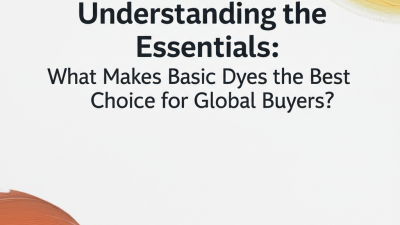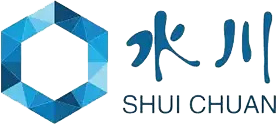In the ever-evolving landscape of the dye industry, understanding the essentials of colorants is crucial for global buyers seeking quality and efficiency. Basic Dyes, characterized by their bright colors and ease of application, have emerged as a favored choice for textile and synthetic fiber industries. According to a recent report by MarketsandMarkets, the global textile dye market is projected to reach $6.1 billion by 2025, with Basic Dyes playing a significant role due to their cost-effectiveness and versatility. The ability of Basic Dyes to achieve vivid shades with excellent colorfastness makes them particularly advantageous in applications ranging from apparel manufacturing to home textiles. As we delve into the key attributes that elevate Basic Dyes above other dye classes, this guide aims to equip buyers with the insights necessary to make informed decisions that enhance product quality and market competitiveness.

Basic dyes have gained significant traction across various industries due to their remarkable versatility and wide-ranging applications. According to a report by MarketsandMarkets, the global dye market is projected to reach USD 36.5 billion by 2025, fueled by the expanding textile and paper sectors. Basic dyes are favored in these industries for their excellent color strength and ease of application, allowing for vibrant finishes on fabrics and high-quality printing on paper products.
In the textile industry, basic dyes are particularly valued for their ability to dye acrylic, wool, and other synthetic fibers. As per a study published by Research and Markets, synthetic textiles are expected to dominate the market, with a growth rate of 5.1% from 2020 to 2025. This growth is largely driven by consumer demand for colorful and durable fabrics, a niche where basic dyes excel. Additionally, their use in the food and cosmetics sectors is on the rise, where they are applied to achieve vivid colors in products while maintaining safety standards. This versatility across multiple industries solidifies the position of basic dyes as a preferred choice for global buyers seeking reliable and dynamic coloring solutions.
When it comes to dye procurement, cost-effectiveness stands out as a crucial component for global buyers. Basic dyes, celebrated for their affordability, provide a perfect balance between quality and price. According to a recent market analysis by Research and Markets, the global dye market is projected to reach $28 billion by 2026, with basic dyes making up a significant share due to their low production costs and wide applicability across various industries. This financial advantage allows manufacturers to maintain competitive pricing while ensuring that their products meet global quality standards.
Tip: When sourcing basic dyes, consider bulk purchasing. Many suppliers offer significant discounts for large orders, which can enhance your overall cost-efficiency. It’s also advisable to explore local suppliers to reduce shipping costs and time.
Furthermore, the ease of application of basic dyes also plays a vital role in their cost-effectiveness. With less energy and time required during the dyeing process, companies can optimize their operations significantly. A report from Allied Market Research indicates that businesses utilizing basic dyes can reduce production costs by up to 15%, thanks to lower processing times and energy savings.
Tip: Always evaluate supplier options and compare their pricing structures. Engaging in long-term contracts can lead to even better pricing strategies and stability in your supply chain.
When considering the choice of dyes for textile production, color fastness and quality stand out as crucial factors for global buyers. Basic dyes, known for their vibrant hues, offer significant advantages in these areas. Their ability to resist fading and maintain consistency through various washes and light exposure makes them an ideal option for apparel manufacturers aiming to meet customer expectations. In today’s market, where fast fashion dominates, maintaining color integrity is paramount for brands to keep their competitive edge.
Tips for Buyers: Look for suppliers who provide data on color fastness ratings specific to basic dyes. This information can help you ensure that the products you source will perform well after multiple uses. Additionally, request samples to conduct your tests on fabric to gauge how the dyes react under different conditions.
Investing in quality dye sources also correlates with the advancement in textile machinery, which has seen improvements that allow better production control. Ensuring that the spinning machines used in creating the textiles are of high quality not only enhances the final product’s durability but also its aesthetic appeal. Incorporating these considerations will facilitate a better sourcing strategy aligned with consumer demands for both personalization and longevity.
| Feature | Description | Advantage | Application Industries |
|---|---|---|---|
| Color Fastness | Resistance to fading and discoloration when exposed to light or washing. | Ensures longevity and quality of dyed products. | Textiles, Home Furnishings |
| Ease of Use | Simplicity in application during dyeing processes. | Reduces time and costs in manufacturing. | Apparel, Fabrics |
| Wide Range of Colors | Availability of different shades and hues. | Meets diverse customer preferences and market demands. | Fashion, Decorative Items |
| Cost-Effectiveness | Affordability compared to other dye options. | Increases margins for manufacturers. | Mass Production Industries |
| Eco-Friendly Options | Availability of sustainable dye formulations. | Supports environmentally-conscious manufacturing. | Eco-Fashion, Organic Products |
As the global market increasingly prioritizes sustainability, basic dyes have emerged as a frontrunner in eco-friendly options for manufacturers and consumers alike. These dyes not only offer vibrant color but also minimize environmental impact, making them an ideal choice for industries seeking to align with sustainable practices. With a focus on reducing water usage and harmful chemicals, the production of basic dyes has evolved significantly, ensuring they meet the demands of eco-conscious buyers.
When selecting basic dyes, it's essential to consider their sourcing and production processes. Look for suppliers that prioritize environmentally-friendly practices, such as using renewable energy sources and adhering to strict waste management protocols. Additionally, check for certifications like OEKO-TEX or GOTS, which indicate that the products meet high ecological standards.
Moreover, opting for dyes that are biodegradable can further enhance the sustainability of your product. Basic dyes derived from natural sources not only reduce reliance on synthetic materials but also break down more easily in the environment, posing less risk to ecosystems. By choosing sustainable dye options, companies can enhance their brand reputation while contributing to a healthier planet.
As the textile and dyeing industries evolve, basic dyes have emerged as a key player in meeting the shifting demands of consumers worldwide. Their affordability and versatility make them a preferred choice among manufacturers seeking to optimize production costs while ensuring vibrant color results. Due to their wide range of applications—spanning from cotton to synthetic fibers—basic dyes cater to diverse consumer markets, adapting seamlessly to the varying preferences and needs of different regions.
Market trends also indicate a growing inclination towards eco-friendly practices, prompting buyers to seek reliable solutions that align with sustainability goals. Basic dyes, due to ongoing advancements in formulation and production techniques, are increasingly being developed with reduced environmental impact. This conscientious approach not only satisfies consumer demands for responsible sourcing but also positions basic dyes as an attractive option in a market that prioritizes sustainability without compromising on quality. As global buyers navigate these changes, the ability of basic dyes to balance performance, cost-effectiveness, and environmental responsibility is setting them apart in the increasingly competitive dye market.
